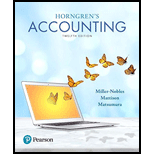
Issuance of Stock:
A company issues common or preferred stock to collect the required amount of capital.
Cash dividend:
The Cash dividend is the amount of dividend paid to shareholders in cash. The Cash dividend is declared first and paid later. There are two journal entries made, one at the time of declaration of dividend and another at the time of payment.
Stock Dividend:
The Stock dividend is the number of shares given as dividend to the shareholders. The Stock dividend is declared first and shares are issued later. There are two journal entries made, one at the time of declaration of stock dividend and another at the time of issuance of shares.
Retained earnings:
The retained earnings are the
Stockholders’ Equity:
Earnings per share:
The Earnings per share is the amount of net income earned by each common share outstanding. The Earnings per share calculated by with help of following formula:
Price Earnings Ratio:
The price earnings ratio shows the relationship between price of the share and earnings per share. It is calculated with the help of following formula:
1. Journalizing the transactions:
To indicate:
The journal entries for the transactions given
2. Stockholders Equity Section of the
To indicate: The Stockholders Equity Section of the balance sheet as on Dec. 31, 2018
3. Earnings per share:
To determine:
The Earnings per share for the year 2018
4. Price Earnings Ratio:
To determine:
The Price Earnings Ratio for the year 2018 is 1.50 Times.
Want to see the full answer?
Check out a sample textbook solution
Chapter 13 Solutions
Horngren's Accounting Plus Mylab Accounting With Pearson Etext -- Access Card Package (12th Edition)

 AccountingAccountingISBN:9781337272094Author:WARREN, Carl S., Reeve, James M., Duchac, Jonathan E.Publisher:Cengage Learning,
AccountingAccountingISBN:9781337272094Author:WARREN, Carl S., Reeve, James M., Duchac, Jonathan E.Publisher:Cengage Learning, Accounting Information SystemsAccountingISBN:9781337619202Author:Hall, James A.Publisher:Cengage Learning,
Accounting Information SystemsAccountingISBN:9781337619202Author:Hall, James A.Publisher:Cengage Learning, Horngren's Cost Accounting: A Managerial Emphasis...AccountingISBN:9780134475585Author:Srikant M. Datar, Madhav V. RajanPublisher:PEARSON
Horngren's Cost Accounting: A Managerial Emphasis...AccountingISBN:9780134475585Author:Srikant M. Datar, Madhav V. RajanPublisher:PEARSON Intermediate AccountingAccountingISBN:9781259722660Author:J. David Spiceland, Mark W. Nelson, Wayne M ThomasPublisher:McGraw-Hill Education
Intermediate AccountingAccountingISBN:9781259722660Author:J. David Spiceland, Mark W. Nelson, Wayne M ThomasPublisher:McGraw-Hill Education Financial and Managerial AccountingAccountingISBN:9781259726705Author:John J Wild, Ken W. Shaw, Barbara Chiappetta Fundamental Accounting PrinciplesPublisher:McGraw-Hill Education
Financial and Managerial AccountingAccountingISBN:9781259726705Author:John J Wild, Ken W. Shaw, Barbara Chiappetta Fundamental Accounting PrinciplesPublisher:McGraw-Hill Education





